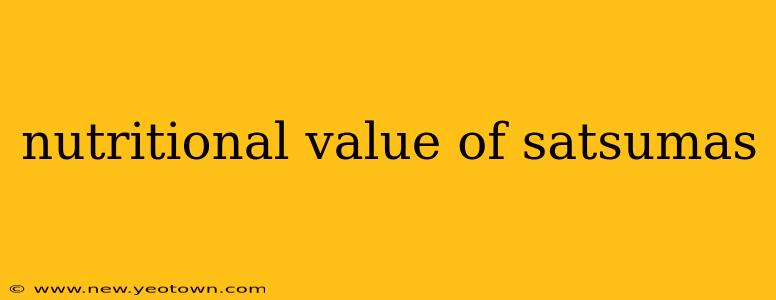Satsumas. Just the name conjures up images of sunshine-kissed orchards and the sweet, juicy burst of flavor in your mouth. But beyond their delightful taste lies a nutritional powerhouse packed with vitamins, minerals, and antioxidants that benefit your overall health. Let's peel back the layers and discover the incredible nutritional value these little citrus wonders offer.
What are the health benefits of eating satsumas?
The health benefits of satsumas are numerous, stemming from their rich vitamin and antioxidant profile. These tiny citrus fruits are packed with Vitamin C, a potent antioxidant that boosts your immune system, protecting your body from damaging free radicals. Regular consumption can help reduce the risk of chronic diseases and keep you feeling your best. Beyond Vitamin C, satsumas also contribute to your daily intake of fiber, crucial for digestive health and maintaining a healthy weight. The antioxidants in satsumas also contribute to improved skin health and may even help protect against certain types of cancer.
Are satsumas good for weight loss?
The short answer is yes, satsumas can be a beneficial part of a weight-loss strategy. Their high fiber content promotes satiety, meaning you feel fuller for longer, reducing overall calorie intake. The relatively low calorie count of satsumas means you can enjoy a satisfying snack without significantly impacting your daily calorie goals. However, it's crucial to remember that weight loss is a holistic process involving diet and exercise. Satsumas are a supportive element, not a miracle cure.
How many satsumas should I eat a day?
There's no strict daily limit, but moderation is key. While satsumas are incredibly nutritious, consuming excessive amounts can lead to an upset stomach due to their acidity. A good guideline is to include 1-2 satsumas as part of your daily fruit intake. Listen to your body; if you experience any discomfort after eating satsumas, reduce your consumption.
Are satsumas better than oranges?
This is a matter of personal preference! Both satsumas and oranges are excellent sources of Vitamin C and other nutrients. Satsumas are generally sweeter and easier to peel, making them a convenient and enjoyable snack. Oranges, on the other hand, offer a slightly more tart and tangy flavor. Ultimately, the "better" fruit depends on your individual taste and dietary needs.
What are the nutritional values in satsumas?
A typical medium-sized satsuma (approximately 80g) contains:
- Vitamin C: A significant portion of your daily recommended intake.
- Fiber: Aids in digestion and promotes regularity.
- Potassium: Important for maintaining healthy blood pressure.
- Antioxidants: Protect your cells from damage.
- Low in calories: Contributes to a healthy weight.
The exact nutritional breakdown can vary slightly depending on the size and growing conditions of the satsuma.
What are the benefits of satsuma juice?
While satsuma juice can be a refreshing drink, it's important to note that it often lacks the fiber found in the whole fruit. The juicing process can also lead to a higher sugar concentration. Therefore, while it offers some of the same nutritional benefits, consuming the whole satsuma is generally a healthier choice.
Conclusion: A Zesty Addition to a Healthy Lifestyle
Satsumas are undeniably a nutritional gem. Their sweet taste masks a wealth of health benefits, from boosting immunity to aiding digestion and contributing to weight management. Incorporating satsumas into your daily diet is a delicious and simple way to enhance your overall well-being. So, next time you're reaching for a healthy snack, remember the zesty goodness and incredible nutritional value of the humble satsuma.

